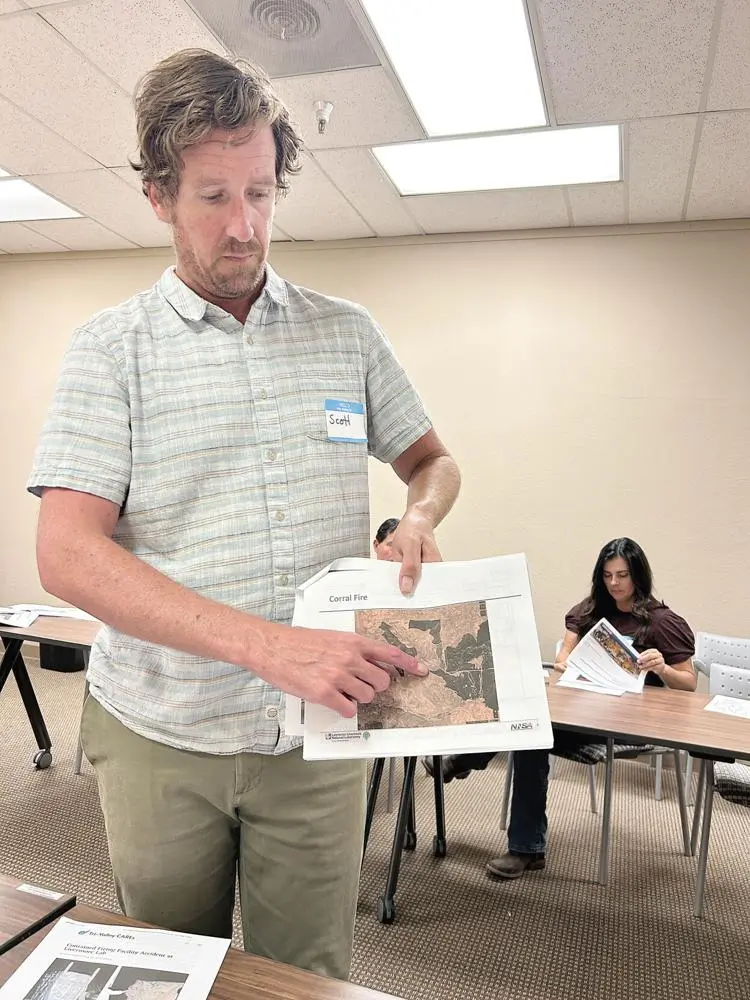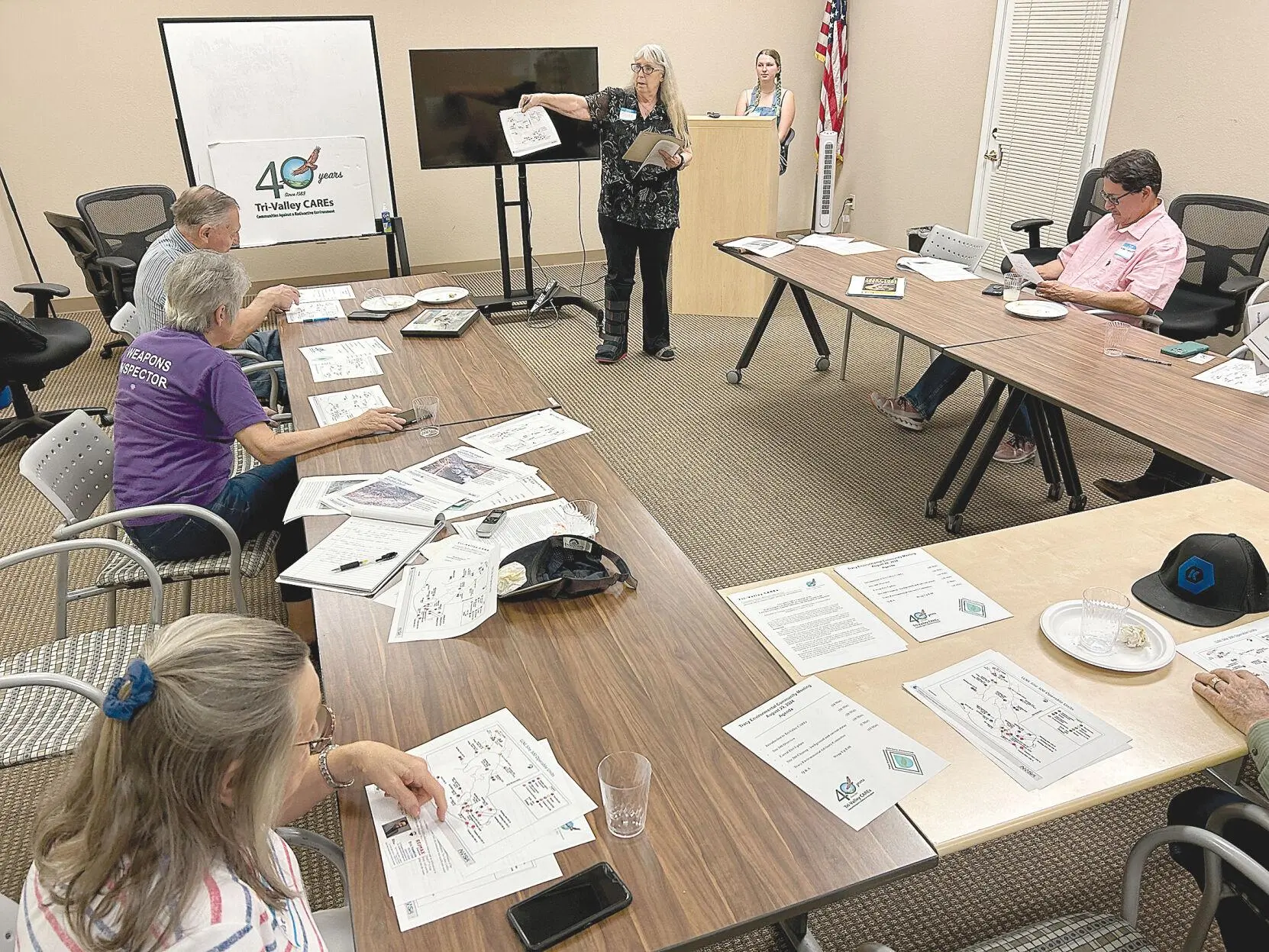
Tri-Valley CAREs Executive Director Scott Yundt points to an aerial image that shows where the Corral Fire started at the southeastern corner of Site 300 just west of Tracy. Bob Brownne/Tracy Press
The Corral Fire that burned 14,168 acres south of Interstate 580 in early June also did significant damage to Site 300, where the blaze reportedly started, and to the infrastructure dedicated to the federally-mandated cleanup of the high-explosives testing range.
Tri-Valley Communities Against a Radioactive Environment (CAREs) — a watchdog group that monitors activities at Lawrence Livermore National Laboratory and Site 300, LLNL’s explosives test facility along Corral Hollow Road southwest of Tracy – sought a meeting with lab officials following the Corral Fire to request an update on the status of groundwater cleanup at the site.
“We called for one of those meetings, and in the agenda, we asked for them to give us an update on how the fire affected the cleanup,” said Scott Yundt, executive director of Tri-Valley CAREs, referring to the June 25 meeting with LLNL staff.
“That enabled the cleanup staff to prepare the report that we have here, that is focused on the cleanup areas, but also talks about the fire more generally. It’s much more information than was publicly disclosed otherwise about the fire in their press release. It has some important information about what burned.”

Tri-Valley CAREs senior advisor Marylia Kelley describes the ongoing groundwater cleanup at Site 300, where the Corral Fire damaged some of the cleanup infrastructure at the site. Bob Brownne/Tracy Press
The report was the topic of the group’s Aug. 29 meeting at WorkVine 209 on Tracy Boulevard, Tri-Valley CAREs presented the report that lab officials provided to the group, when the lab updated the group on Site 300 cleanup efforts, and the effects of the Corral Fire.
Yundt explained that Lawrence Livermore National Laboratory is one of two U.S. Department of Energy nuclear weapons research and development sites – Los Alamos National Laboratory in New Mexico is the other – and was established in 1952. Site 300, 11 square miles of rolling hills on the south side of Corral Hollow Road, was established in 1955 as a remote outpost where the lab could test the high explosives used to detonate nuclear weapons. No production or testing of actual nuclear weapons has ever taken place at Site 300 or at the Livermore Labs, Yundt added.
But the high explosives testing, including use of uranium 238, or depleted uranium, and related activities did result in the discharge and spread of toxic substances.
Marylia Kelley, one of the founders in 1983 and now a senior advisor of Tri-Valley CAREs, described how debris and residue from those tests was gathered and dumped in unlined pits around the site.
“After the unlined pits were completely filled they were capped and during some heavy storm events groundwater levels rose as much as 10 feet, inundating the pits and mixing with the contaminated waste that was dumped in there, and washing out,” Kelley said.
“The pits have leaked uranium, tritium, perchlorate and other contaminants into the groundwater aquifer at high concentrations, and the groundwater vibrated outside of the pits and now forms a long plume.”
In 1990 Site 300 was added to the U.S. Environmental Protection Agency’s National Priorities List (Superfund). Since then the U.S. Department of Energy and LLNL have been cleaning up the groundwater, primarily through pump-and-treat systems. The EPA reports that cleanup has had much success, including some groundwater plumes that have been completely remediated.
Other areas are still contaminated, the EPA reports, including parts of the southeast area of Site 300 where the Corral Fire burned.
The report that lab officials shared with Tri-Valley CAREs includes descriptions of the facilities that were damaged by the fire. It includes 10 pump-and-treat systems that were damaged, 21 monitoring wells that were put out of commission, and several pipelines that run between these systems, with the breach of one section of pipe causing 6,000 gallons of contaminated water to spill back onto the ground.
There were also two unoccupied buildings that were damaged, as well as a vapor extraction system.
“The general service area where the fire rushed through contains more than cleanup sites,” Yundt added. “There’s hazardous waste stored there, there’s high explosives stored there. There’s programmatic work where they prepare high explosives there, and the fire did rush through there, and they did not give us a report from any of that staff, the programmatic staff. By programmatic I mean, people who work on the active program of high explosives, rather than work on cleanup.”
The cause and origin of the fire is still unclear. The lab was known to be conducting its annual prescribed burns to eliminate tall grass in late May. Yundt noted that while prescribed burns were completed in a couple of areas, the lab halted that work 2 days before the Corral Fire, calling off any further controlled burns at the time because of high winds through the area.
“Cal Fire apparently has conducted an investigation into the cause, and the lab suggested it was inconclusive, or concluded that it was not started by the prescribed burn,” Yundt said. “We used the California Public Records Act to request their investigation, and they claimed that because the fire started on private property they do not have to disclose the investigation.”
The main concern for Tri-Valley CAREs now is to see that the Superfund cleanup gets back on track.
“At the meeting last month at the lab, they let us know that for fiscal year 2025 the budget for cleanup at Site 300 is cut 10% across the board, and they can’t take it from the main site cleanup because that’s also cut 10%,” Yundt said, though the group also sees an increase in the lab’s overall budget of about $2.5 billion.
“There is not an overall budget problem. This is a priorities problem.”
Click here for Lawrence Livermore Lab’s presentation on the fire
Click here or below to read Tri-Valley CAREs’ article about the Corral Fire:

